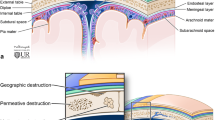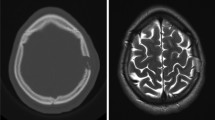Abstract
We reviewed the imaging of four pathologically proven calvarial eosinophil granulomas. The diameter of the lesions ranged from 13 to 40 mm; three were biconvex, but the other had a collar-stud appearance. Two lesions were in the frontal and two in the parietal bone. On bone-window CT, a bevelled edge was seen in three cases and button sequestration in one, but no sclerotic rim was shown. Although one lesion had a low-density area, the lesions were slightly denser than grey matter. They were isointense with grey or white matter on T1-weighted MRI and gave heterogeneous high signal on proton-density and T2-weighted images. All enhanced markedly, with a less strongly enhancing portion within them. A tail of dural enhancement and reactive change in the overlying galea or temporal muscle were seen in all cases.
Similar content being viewed by others
Author information
Authors and Affiliations
Additional information
Received: 24 November 1998 Accepted: 5 February 1999
Rights and permissions
About this article
Cite this article
Okamoto, K., Ito, J., Furusawa, T. et al. Imaging of calvarial eosinophil granuloma. Neuroradiology 41, 723–728 (1999). https://doi.org/10.1007/s002340050831
Issue Date:
DOI: https://doi.org/10.1007/s002340050831




